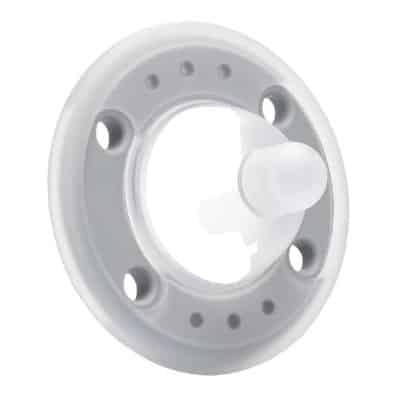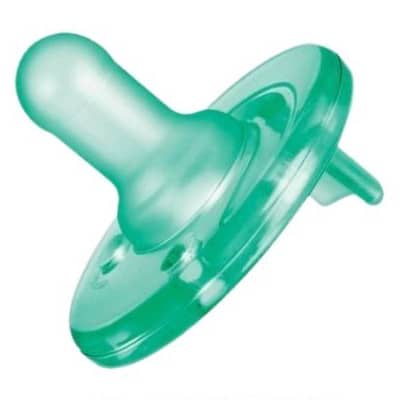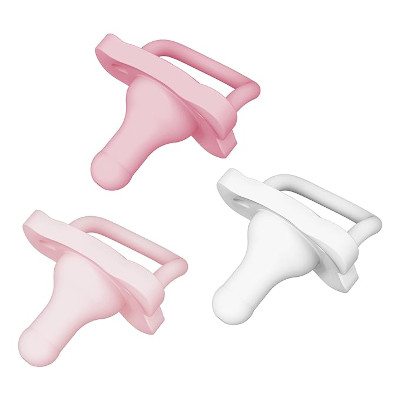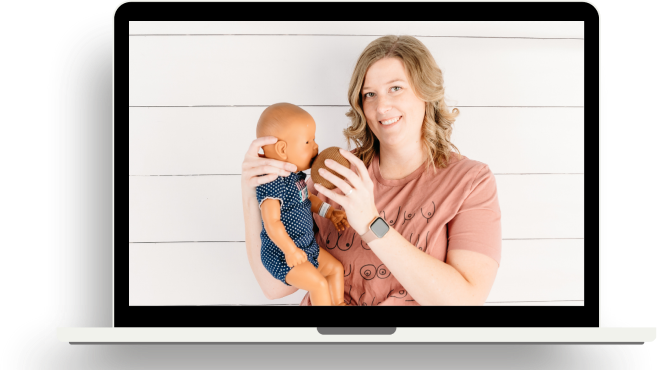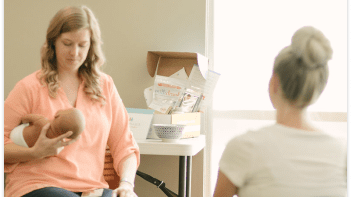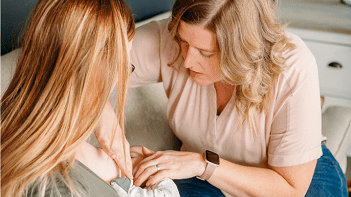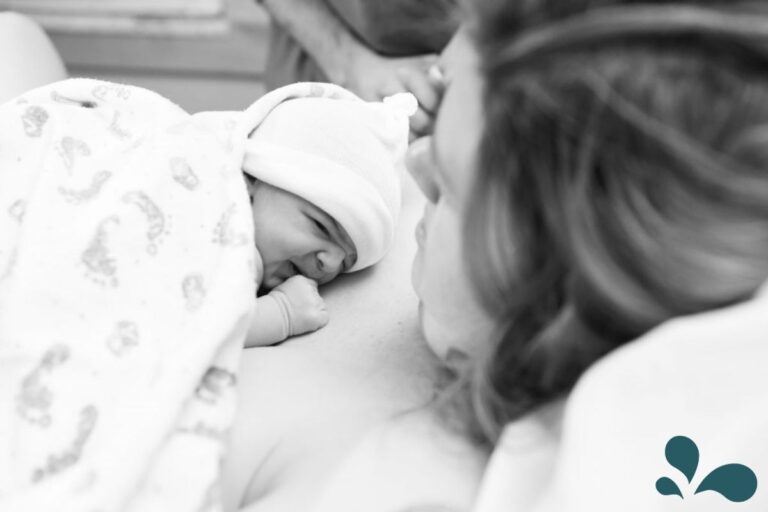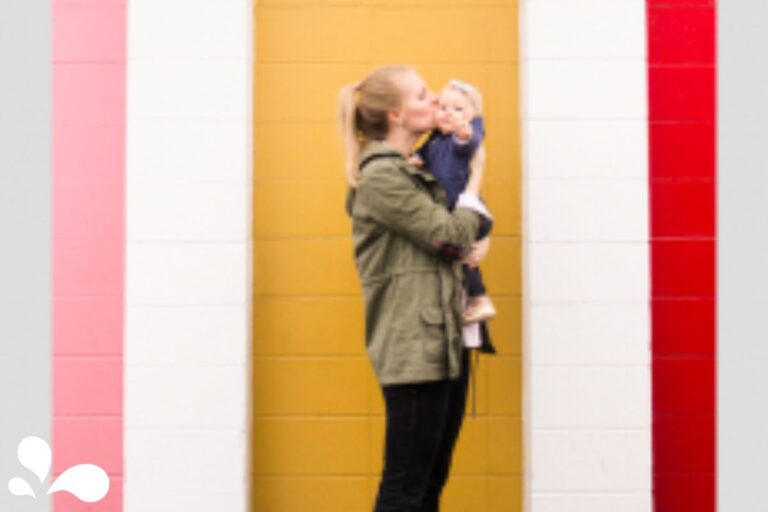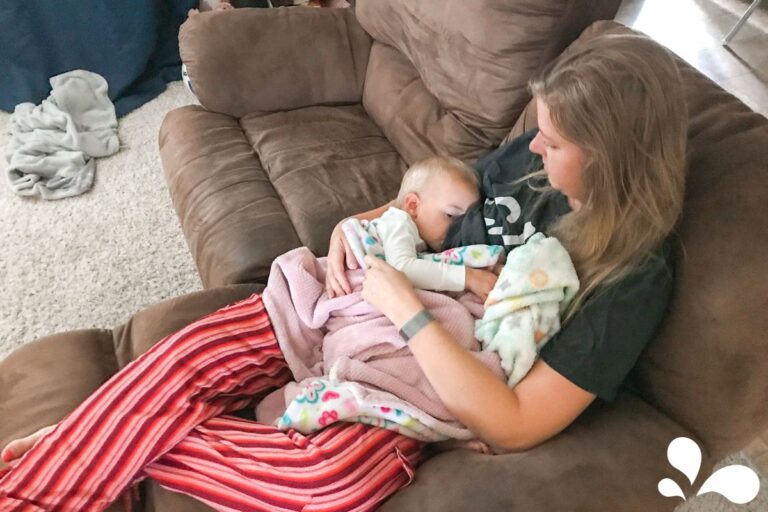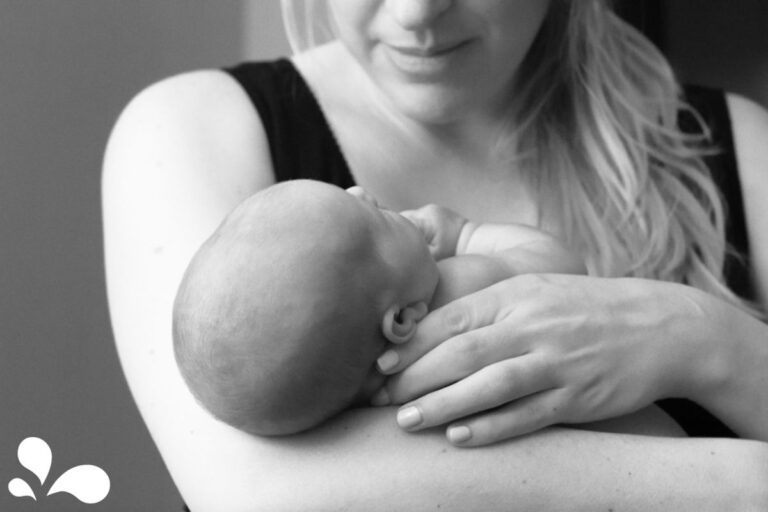As a new mama, calming your baby is crucial for both their well-being and your peace of mind. Soothing a fussy baby is a top priority, and sometimes, a pacifier can be a lifesaver. If your baby is breastfeeding well and doesn’t have any issues with latch or feeding, the best pacifier might simply be the one they accept most readily—and that’s perfectly okay.
Remember, every baby is unique. Trust your instincts and your baby’s cues to find what works best for both of you.
With years of experience supporting parents as IBCLCs, we’ve had many mamas just like you ask us about which pacifiers we recommend that support breastfeeding (or at least might help avoid problems).
We’re here to help you make informed decisions that benefit both you and your baby. Let’s get straight to our top pacifier recommendations.
Top pacifiers we recommend
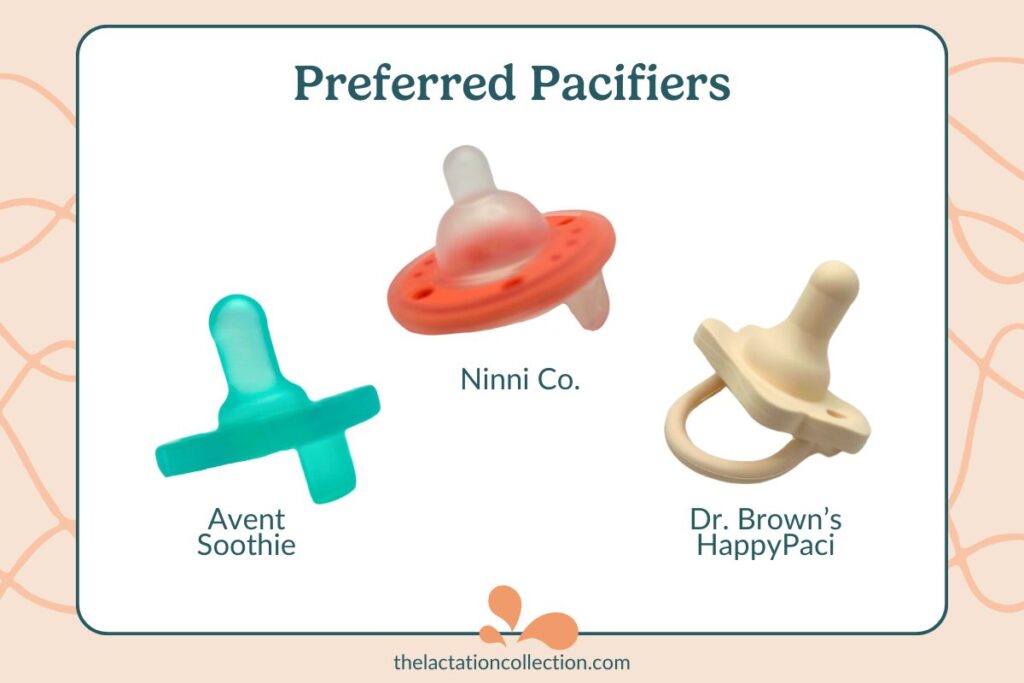
- Ninni Co. Pacifier: This pacifier closely mimics the breast, featuring a straight nipple with a wide, soft base to help your baby achieve a deep latch. It’s made from hospital-grade silicone and is used by infant oral physical therapists and IBCLCs for suck training. It’s also dishwasher safe.
Ninni Co. Pacifier
(use code TLCMAMA for 10% off your purchase)
- Philips Avent Soothie: Widely used in hospitals across the US, this pacifier has a straight nipple with a wide base, made from hospital-grade silicone. Its one-piece construction ensures safety and easy cleaning.
Avent Soothie (0-3 months)
(when needed, size up to the 3-18 month size)
- Dr. Brown’s HappyPaci: Economical and practical, this pacifier mirrors the nipple of Dr. Brown’s bottles, making it easier for babies to transition between feeding and soothing. Crafted from soft, durable silicone, it’s gentle on your baby’s mouth and safe for everyday use. The design is ideal for parents seeking a cost-effective, high-quality option that aligns with their bottle-feeding routine.
These pacifiers are designed to complement breastfeeding, not interfere with it.
The Ninni Co. pacifier’s wide, soft base supports natural sucking patterns, making it easier for your baby to switch between breast and pacifier.
All three pacifiers feature a straight nipple design that helps to maintain a natural sucking motion and are made from safe, durable hospital-grade silicone.
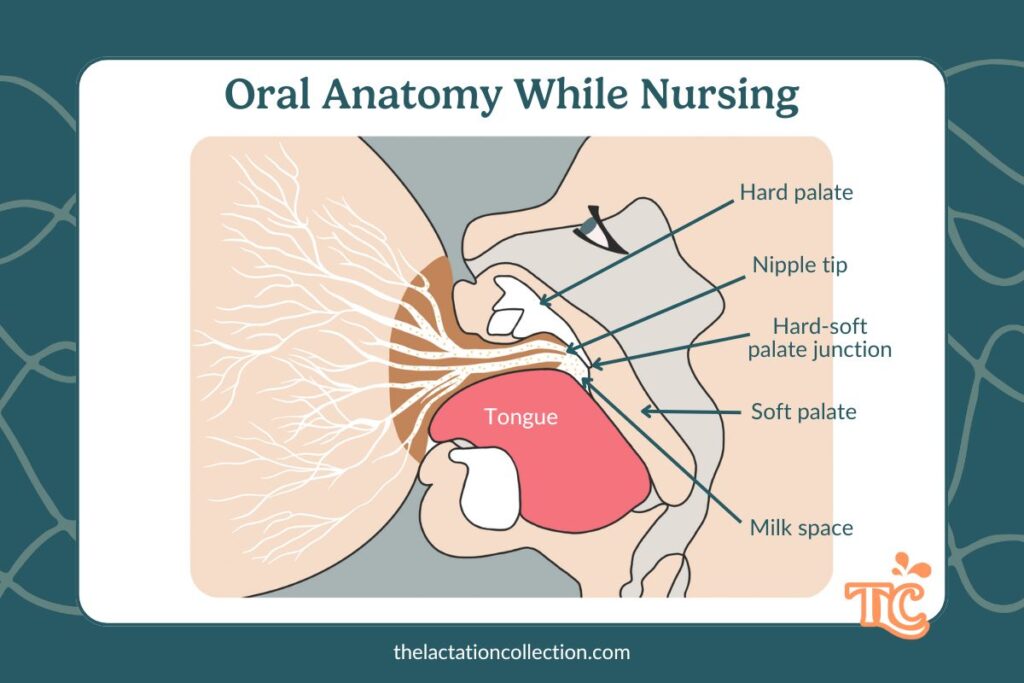
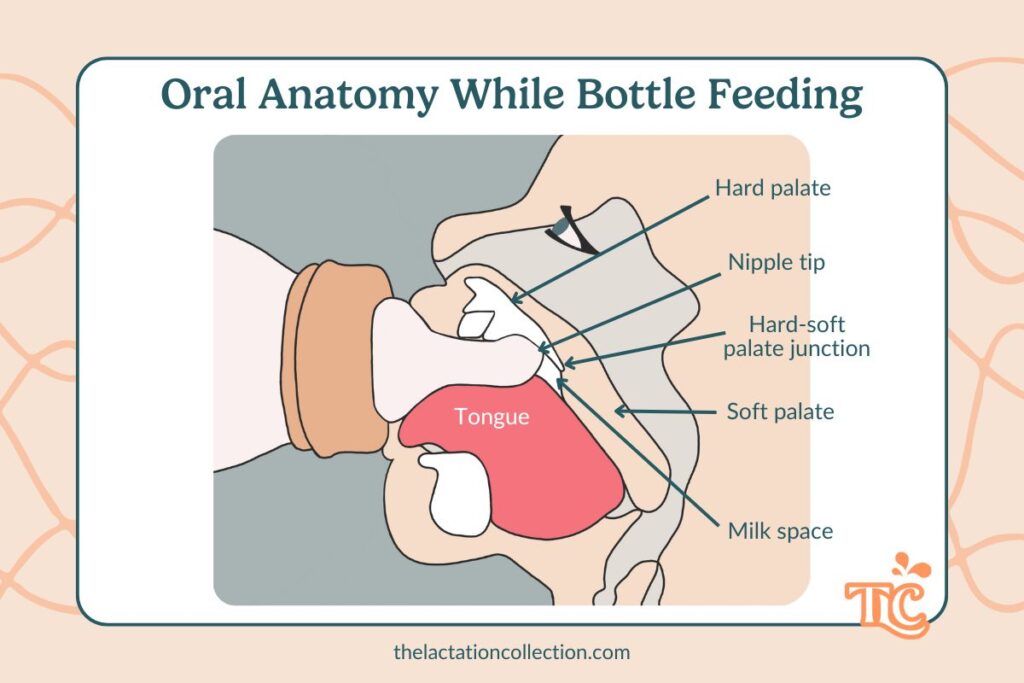
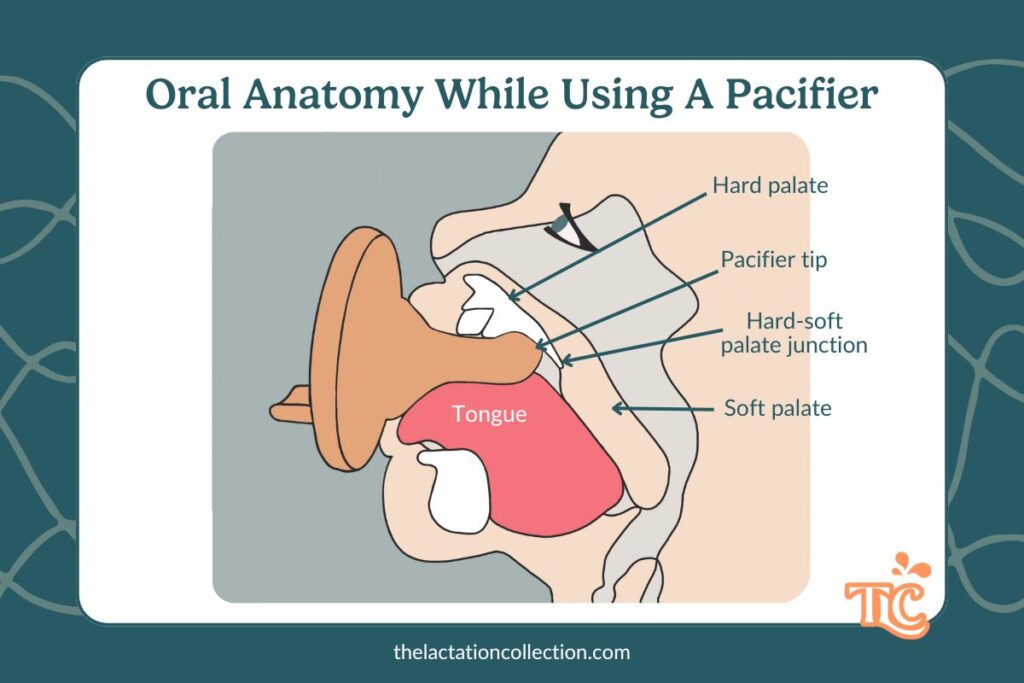
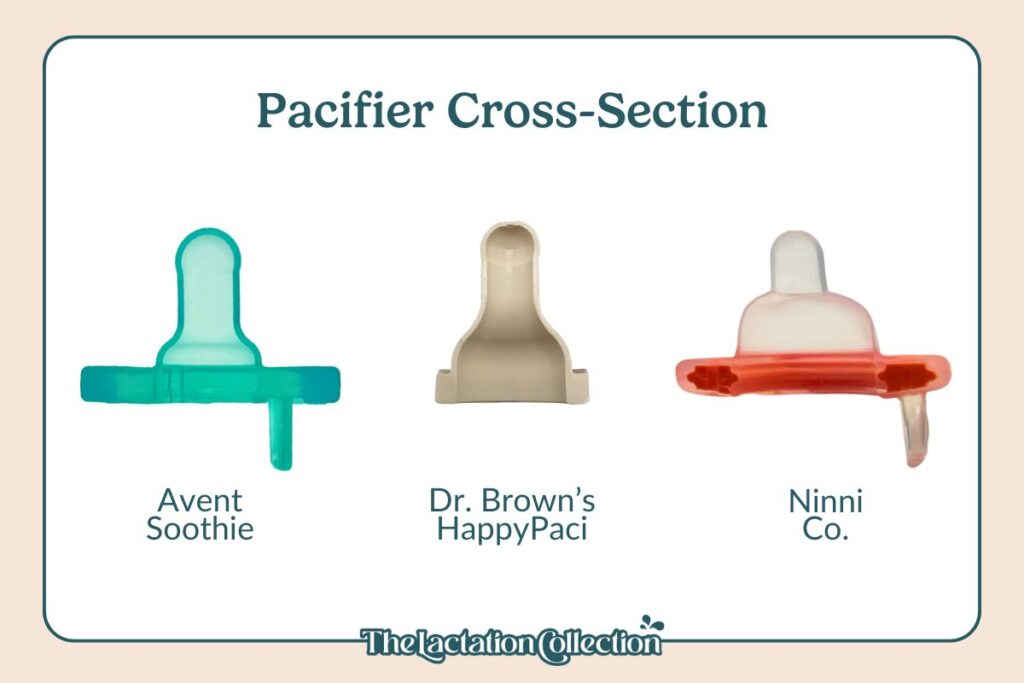
Ensuring proper oral mechanics is key to a successful breastfeeding experience. Studies such as those by Kronborg & Vaeth (2009) have documented that the use of artificial nipples, including pacifiers, can interfere with the natural latch by changing the infant’s positioning and the way their mouth engages during feeding. When a pacifier nipple is too short or positioned too far forward, it can lead to inadequate jaw movement and poor lip sealing. This reinforces the importance of choosing a pacifier with a design that closely resembles the natural breast—featuring a wide, soft base and straight nipple—to promote a deep and effective latch.
Kronborg & Vaeth (2009)[5]
Choosing the best pacifier for your baby: your 2-step decision guide
Even though we’ve recommended three excellent pacifiers—each backed by our team’s experience—you might wonder which one is best for your baby.
Our top pacifier recommendations have been carefully chosen for their breastfeeding-friendly design, minimizing latch issues and other common challenges our team regularly helps mamas overcome. However, every baby is unique, so it’s important to choose a pacifier that meets your child’s individual needs.
This decision guide will help you evaluate our recommendations and create your own selection criteria, and help you choose a pacifier that not only soothes your baby but also aligns with your breastfeeding goals.
1. Our pacifier selection criteria checklist
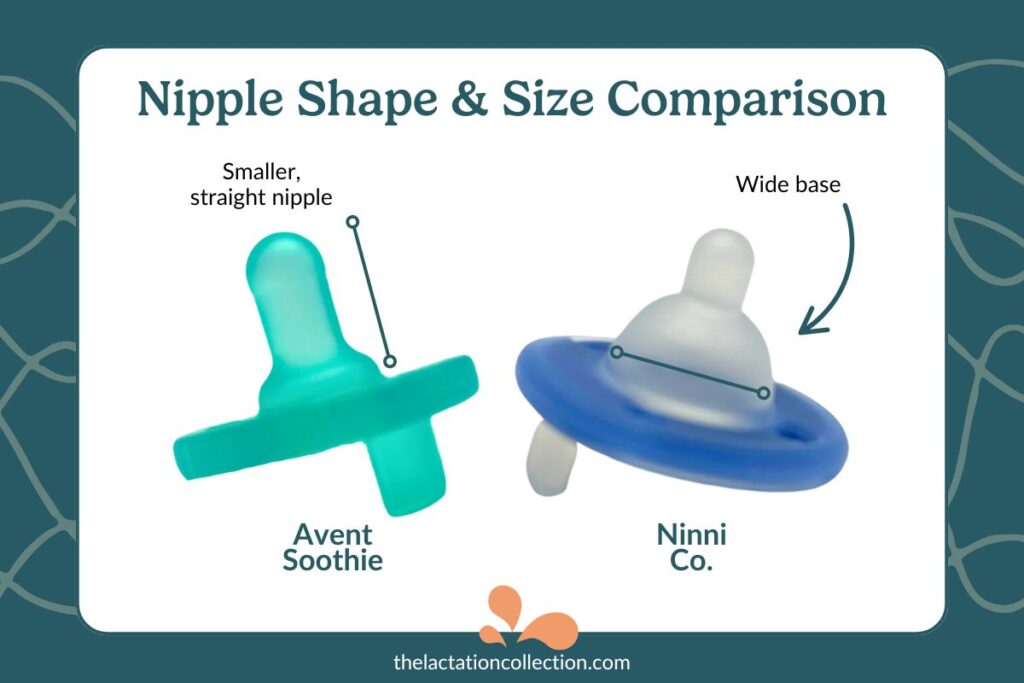
When choosing a pacifier, we consider these key factors:
- Nipple Shape and Size: Opt for a pacifier that suits your baby’s age and mouth size. Smaller, straight nipples like the Philips Avent Soothie may be best for newborns.
- Material and Safety: Choose pacifiers made from hospital-grade silicone, like Ninni Co. and Philips Avent Soothie, ensuring durability and safety.
- Design for Oral Development: A pacifier that mimics the breast, such as the Ninni Co., supports natural muscle development and smoother transitions between breast and pacifier.
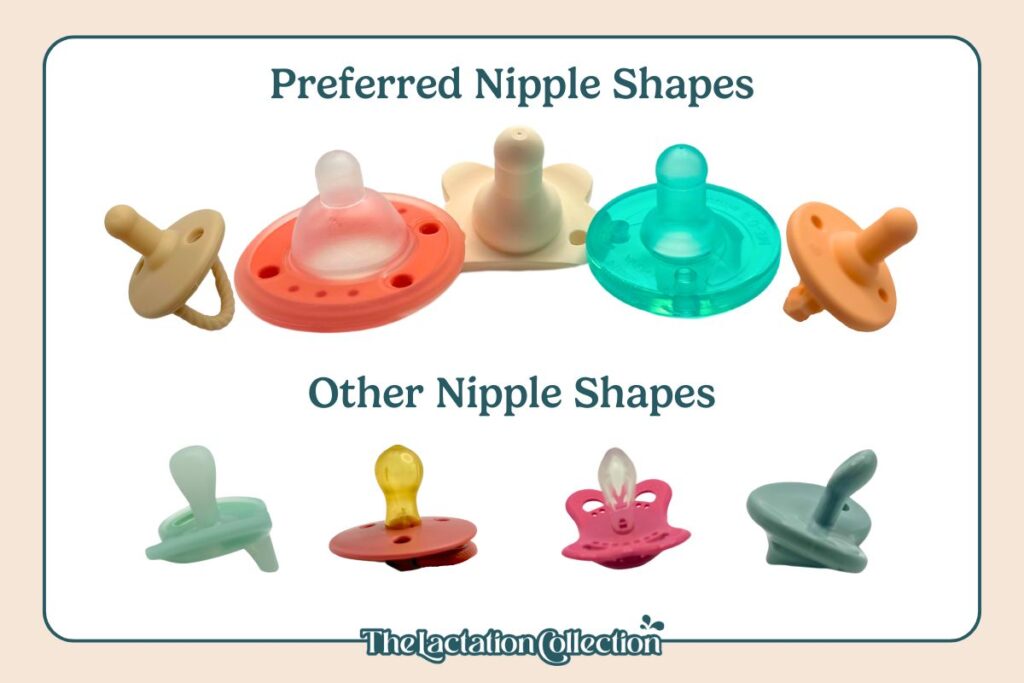
Pacifier shapes we do not recommend and why:
- Short/Forward-Positioned Nipples may restrict jaw movement, resulting in a shallow latch and increased nipple pain.
- Long, Narrow Nipples can impair lip sealing by causing gaps, which may lead to inefficient milk transfer.
- Bulbous or Round-Tipped Nipples disrupt proper tongue cupping, reducing effective sucking activity.
- Orthodontic-Shaped Nipples may interfere with the natural grooving or cupping of the tongue and alter stress distribution on the palate, potentially impacting palatal development, dentition, and speech.
Research Sources:
Batista et al. (2019)[4]:
Finding: Changes in pacifier/bottle nipple design (e.g., short/forward-positioned and long, narrow nipples) are associated with altered jaw movement and lip sealing, contributing to shallow latch and inefficient milk transfer.Wolf & Glass (1992)[6]:
Finding: Bulbous or round-tipped nipples can disrupt proper tongue cupping, reducing effective sucking activity, and orthodontic-shaped nipples may interfere with the natural grooving or cupping of the tongue.Levrini et al. (2007)[7]:
Finding: Different pacifier geometries affect the distribution of stress on the palate; specifically, narrow or bulb-like tips concentrate stress centrally, which can negatively impact palatal development, dentition, and speech.
2. Baby considerations when choosing a pacifier
Tailor your pacifier choice based on your baby’s unique needs:
- Feeding Habits: If your baby has a strong latch, you have more flexibility. A breast-like pacifier can complement their feeding routine.
- Baby’s Preferences: Babies might prefer certain nipple shapes or textures. Experiment with different options if one is rejected.
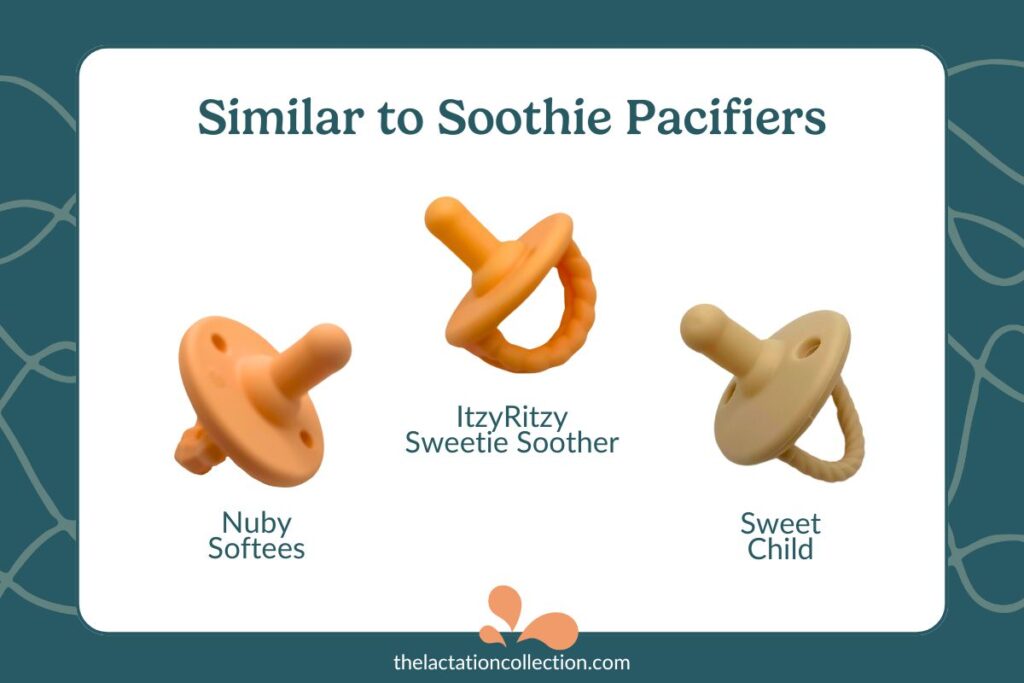
- Introduction and Weaning: Start with short, monitored use, and plan to wean off before 12 months to prevent dental issues [1]. Adjust based on how your baby responds to make sure it aligns with breastfeeding.
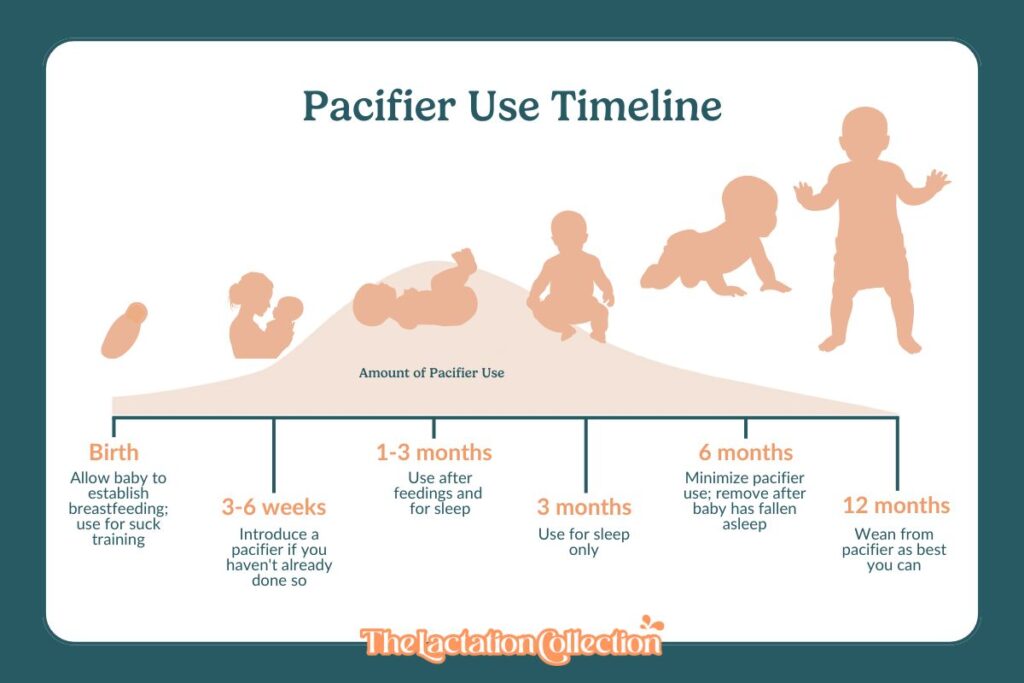
By keeping these tips in mind, you can find a pacifier that works in harmony with breastfeeding, bringing comfort to both you and your baby.
Using a pacifier without disrupting breastfeeding
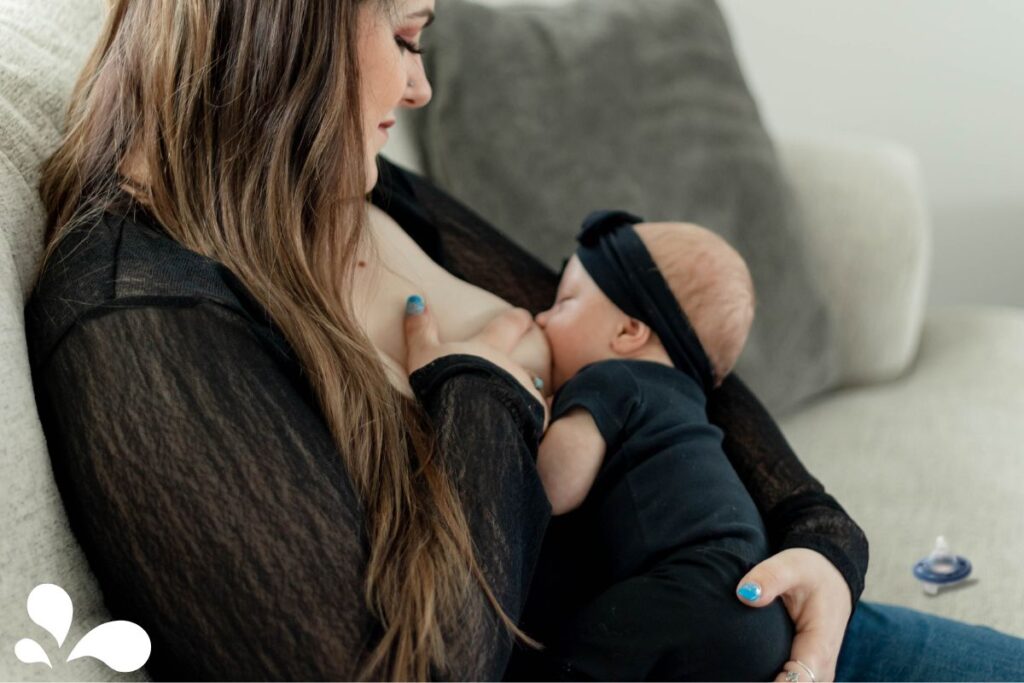
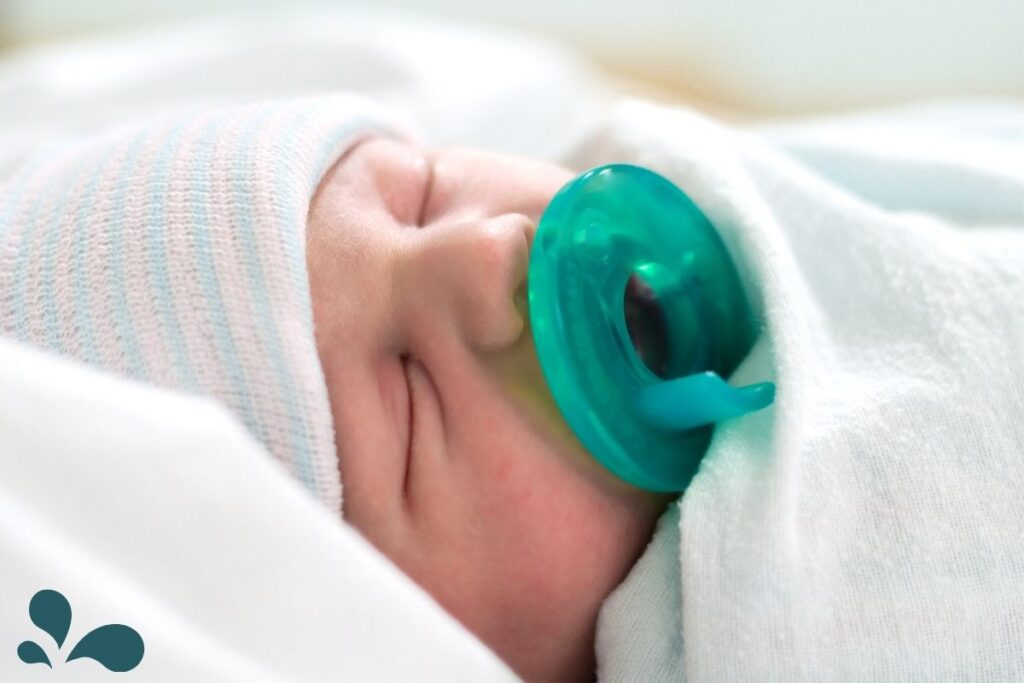
Tips to help you use a pacifier without disrupting breastfeeding
Early introduction, if needed:
- You can introduce a pacifier as early as day one, especially since pacifiers can assist with suck training and support breastfeeding.
Interestingly, a study found that hospitals restricting pacifier distribution saw lower exclusive breastfeeding rates. This suggests that when used appropriately, pacifiers do not necessarily interfere with breastfeeding, particularly for mamas who are already committed to breastfeeding.[2]
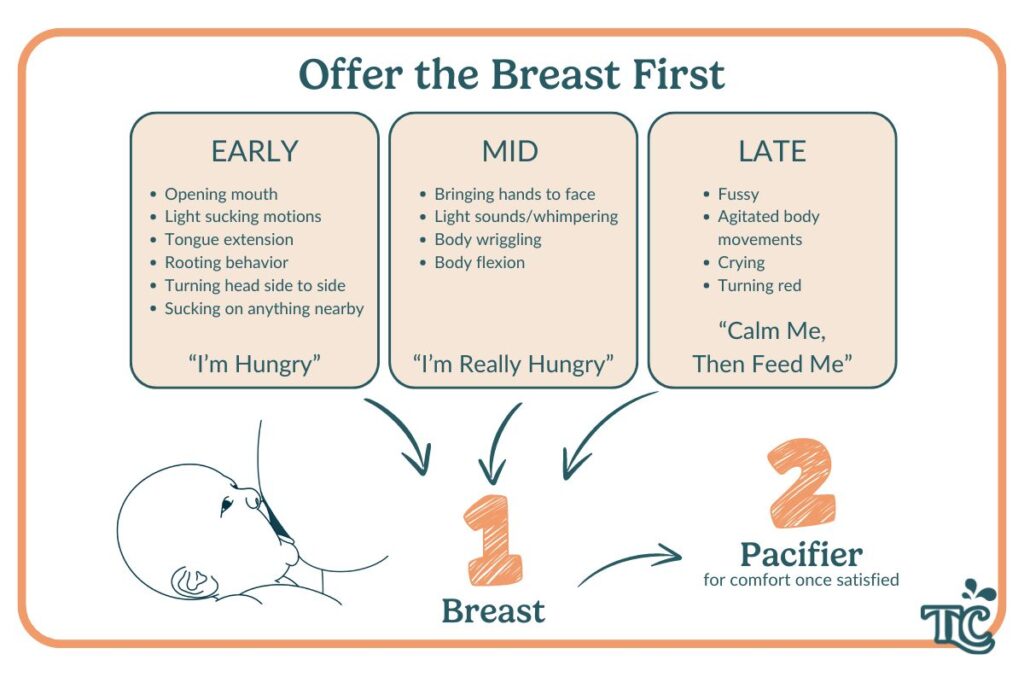
Offer the breast first (after reading baby’s hunger cues):
- Make sure your baby is fully satisfied after breastfeeding before offering a pacifier.
- This helps maintain your milk supply and encourages the pacifier to be used for comfort, not as a substitute for feeding.
Start pacifier use gradually:
- Begin with short periods of pacifier use.
- Observe how your baby responds and watch for any changes in feeding behavior.
- Adjust pacifier use as needed to maintain a healthy breastfeeding routine.
Monitor pacifier usage:
- Use the pacifier for soothing, but avoid prolonged use (longer than 1-2 hours) during the first few weeks after birth.
- This helps prevent potential negative impacts on breastfeeding sessions and oral development.
Recent research has shown that the shape of a pacifier nipple can significantly influence your baby’s oral mechanics during feeding. Batista et al. (2019) compared sucking patterns in infants using pacifiers and bottle nipples versus those who weren’t. Their findings indicated that shorter, forward-positioned nipples can alter natural jaw movement, lip sealing, and tongue cupping. This altered mechanics may lead to a shallow latch and result in nipple pain. That’s why we recommend pacifiers with a wide, straight nipple design—they better mimic the natural shape of the breast and support an effective latch.
Check for pacifier overuse:
We don’t want pacifier overuse to lead to a lower milk supply.
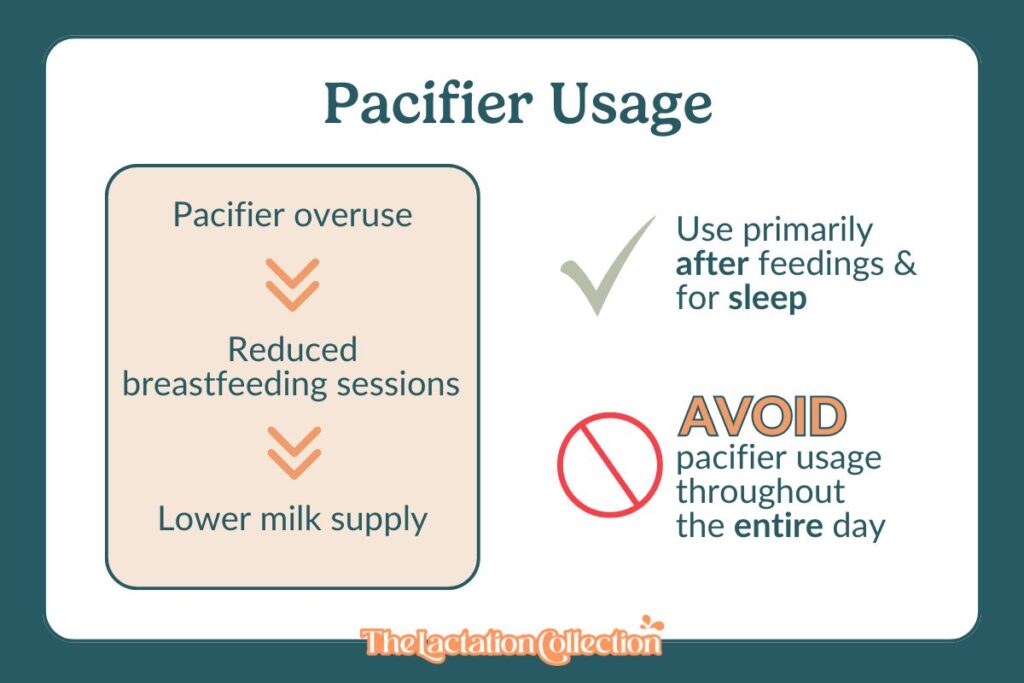
- While pacifiers are great for soothing, overuse can sometimes reduce breastfeeding sessions, potentially impacting milk supply.
- Aim to use the pacifier primarily during specific times, like naps or bedtime, rather than throughout the day.
In fact, the American Academy of Pediatrics (AAP) recommends offering a pacifier at naptime and bedtime, as it has been linked to a lower risk of Sudden Infant Death Syndrome (SIDS).[3]
Appropriate ages for pacifier use:

- Using a pacifier from the newborn stage can be beneficial, particularly for soothing and reducing the risk of SIDS.
- However, it’s recommended to wean your baby off the pacifier between 6-12 months to minimize the risk of dental issues.[1]
Choose the right time to use a paficier:
- Offer the pacifier when your baby naturally seeks comfort, such as during naps or bedtime.
- Avoid using a pacifier as a way to delay or replace feedings.
Using a pacifier during growth spurts:
- During growth spurts or cluster feeding periods, your baby may want to nurse more frequently.
- Prioritize breastfeeding during these times to maintain supply and meet your baby’s nutritional needs.
- Avoid using the pacifier to delay or replace feedings during growth spurts.
Do you think you have low milk supply?
These blog posts will help you identify and overcome low milk supply:
Debunking the myth: Do pacifiers harm breastfeeding?
If you’ve heard that introducing a pacifier too soon might interfere with breastfeeding, you’re not alone. But here’s the truth—research suggests otherwise.
A study published in Pediatrics[3] found that hospitals that stopped giving out pacifiers actually saw a drop in exclusive breastfeeding rates. This challenges the idea that pacifiers harm breastfeeding. Instead, it suggests that when used wisely, pacifiers may actually help support breastfeeding by providing comfort without replacing feedings.
Additionally, there’s no strong evidence linking pacifier use to latch issues in babies who are already nursing well—especially when choosing a pacifier with a nipple shape that supports natural sucking (like a straight, wide-based design).
💡 Key Takeaway: If your baby is latching well and gaining weight, there’s no need to stress about using a pacifier. Just remember to offer the breast first, use the pacifier for comfort (not instead of feeding), and keep an eye on your baby’s nursing patterns.
Keep in mind: balance pacifier use and your breastfeeding goals
The right pacifier can support your breastfeeding journey, offering comfort to your baby while keeping breastfeeding the priority. With the right pacifier and thoughtful use, you can find a balance that works for you and your baby.
Remember, every baby is different, so trust your instincts and use the knowledge you’ve gained here. If you need further guidance or have any other questions, don’t hesitate to reach out to our team. We’re here to support you every step of the way.
It’s okay to adjust your approach as you learn more about your baby’s needs and preferences.
Use your best judgement to find pacifiers designed with your baby’s natural oral mechanics in mind to support comfortable, effective feeding.
Get personalized support when you need it
We created this blog post and website as a quick & easy resources to help answer your questions about pacifiers and breastfeeding.
If you need more personalized support, our team of IBCLCs is here for you. Whether you prefer a virtual consultation or an in-person visit, you can easily schedule time with one of our experienced consultants.
Our primary goal is to provide you with the guidance and reassurance you need to be successful with your breastfeeding journey, however you define that.
Remember, finding the right balance is key. You’re already doing great by seeking the best information for your baby. We’re here to support you every step of the way.
Sources
[1] AAPD Policy on Pacifiers (2024)
According to the AAPD, pacifiers should ideally be weaned off by 12 months to prevent dental concerns, with prolonged use past 36 months increasing the risk of alignment issues.
[2] AAP Pacifier Restriction and Exclusive Breastfeeding
According to a study published in Pediatrics, there is no strong evidence that pacifier use disrupts breastfeeding in motivated mamas. And that pacifier use does not inherently cause latch issues or breastfeeding difficulties in mamas who are already successfully nursing. This means that if breastfeeding is going well, introducing a pacifier as a soothing tool is unlikely to cause issues.
[3] SIDS and Other Sleep-Related Infant Deaths (AAP)
Using a pacifier for sleep has been shown to reduce the risk of SIDS, according to the AAP’s safe sleep guidelines.
[4] Batista et al. (2019)
This study compared nutritive and non-nutritive sucking patterns among infants using pacifiers or bottle nipples versus those who did not. The research demonstrated that the use of a baby bottle, in particular, was associated with changes in jaw movement, lip sealing, and tongue cupping.
[5] Kronborg & Vaeth (2009)
Their research highlighted that the use of artificial nipples (including pacifiers) can affect the breastfeeding process by changing latch quality and positioning during feeding.
[6] Wolf & Glass (1992)
Bulbous or round-tipped nipples can disrupt proper tongue cupping, reducing effective sucking activity, and orthodontic-shaped nipples may interfere with the natural grooving or cupping of the tongue.
[7] Levrini et al. (2007)
Finding: Different pacifier geometries affect the distribution of stress on the palate; specifically, narrow or bulb-like tips concentrate stress centrally, which can negatively impact palatal development, dentition, and speech.


